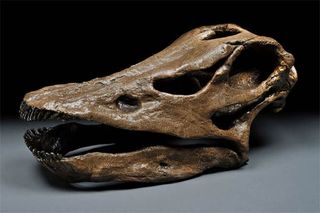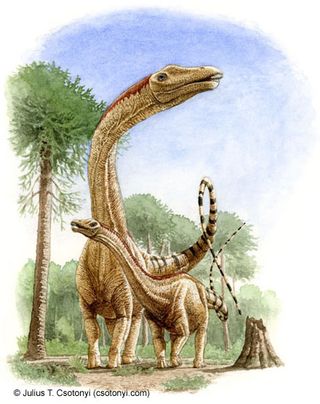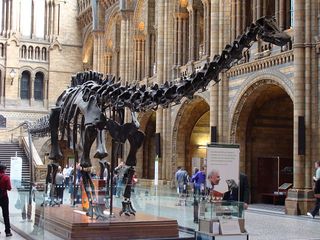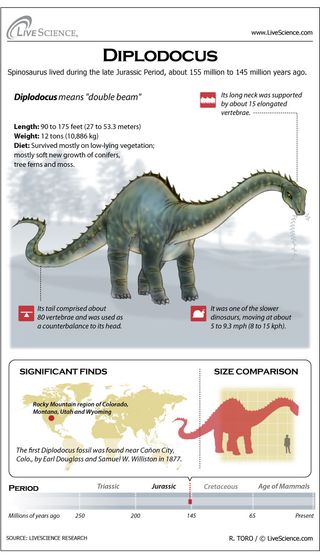Diplodocus: Facts About the Longest Dinosaur

One of the longest dinosaurs, Diplodocus had a unique body construction, with two rows of bones on the underside of its tail to provide extra support and greater mobility.
Because of Diplodocus' unusual skeleton, paleontologist Othniel C. Marsh coined its name in 1878, deriving it from the Greek words "diplos," meaning "double," and "dokos" meaning "beam."
One of the best-known sauropods (long-necked herbivorous dinosaurs), this genus of dinosaur lived during the late Jurassic Period, about 155.7 million to 150.8 million years ago, and primarily roamed western North America. Four species are recognized: D. longus, D. carnegii, D. hayi and D. hallorum (previously known as Seismosaurus).
Diplodocus is the longest dinosaur known from a near-complete skeleton — that is, other dinosaurs, such as the sauropod Supersaurus, may be longer, but those length estimates are based on fairly incomplete skeletons.
The best-known Diplodocus species, D. carnegii, of which there's a near-complete skeleton, was about 90 feet (27.4 meters) long. The largest species, D. hallorum, was about 108 feet (33 m) long, according to a 2006 report in the New Mexico Museum of Natural History Bulletins.
The majority of Diplodocus' length was taken up by its neck and tail. For instance, the neck alone of D. carnegii was at least 21 feet (6.5 meters) long, according to a 2011 study in the Journal of Zoology, and its tail was even longer.

Diplodocus' long tail possibly served as a counterbalance for its neck. A 1997 study in the journal Paleontology also found that diplodocids — dinosaurs in the Diplodocidae taxonomy family, which includes Diplodocus and Apatosaurus (formerly Brontosaurus) — could whip the tips of their tails at supersonic speeds, producing a canonlike boom, possibly to intimidate would-be attackers or rivals, or for communication and courtship.
Massive dinosaur
Estimating the mass of dinosaurs is often difficult, and modern estimates of Diplodocus' mass (excluding D. hallorum) have ranged between 11 and 17.6 tons (10 to 16 metric tons). The dinosaur's large tail placed its center of mass pretty far back on its body, said David Button, a paleontologist at the University of Bristol in the United Kingdom.
"It seems that its center of mass is so far back that it wouldn't have been able to walk very quickly," Button told Live Science, adding that this center-of-mass position would have also made rearing up on its hind legs rather easy for Diplodocus.
Based on a 1910 reconstruction of Diplodocus by paleontologist Oliver P. Hay, scientists initially thought that Diplodocus' posture was more lizard-like, with splayed limbs,. However, paleontologist William J. Holland argued that such a posture would have required a large ditch to accommodate the dinosaur's stomach. In the 1930s, fossil footprints, or "trackways," suggested Diplodocus walked with its broad legs straight down, like an elephant.
Like some other sauropods, Diplodocus' nasal openings sat high up on its forehead instead of at the end of its snout. At one point, scientists thought that Diplodocus may have had a trunk. However, a 2006 study in the journal Geobios concluded that Diplodocus didn't have the neuroanatomy that could support a trunk, after comparing skulls of the dinosaur with those of elephants.
Another theory explaining Diplodocus' high nasal openings proposed the dinosaur needed this adaptation to live in water. But sauropods likely weren't suited for aquatic life, because they had pockets of air inside their bodies that would have made them too buoyant (and unstable) in deep water, according to a 2004 study in the journal Biology Letters
Diplodocus had five-toed broad feet, with the "thumb" toes sporting a claw that was unusually large, compared with other sauropods. It's not known what purpose this claw served for Diplodocus or other sauropods.
Fossilized skin impressions described in a 1992 Geology paper suggest that diplodocids may have had small, keratinous spines along their tails, bodies and necks.
Like other sauropods, Diplodocus probably grew very quickly, reached sexual maturity at about 10 years of age, and continued to grow throughout life, according to a 2004 study in the journal Organisms Diversity & Evolution.
No direct evidence of Dipolodocus' nesting habits exists, but it's possible the dinosaur, similar to other sauropods, laid its eggs in a communal area containing vegetation-covered shallow pits.

What did Diplodocus eat?
According to a 2009 article in the journal Acta Palaeontologica Polonica, Diplodocus probably held its neck at a 45-degree angle most of the time. However, it's unclear if the animal had the neck flexibility that would allow it to reach both plants on the ground and leaves at the top of trees, without moving its body.
"Neck flexibility is a controversial topic in sauropods," Button said. Most recently, a 2014 study in the journal PeerJ suggests Diplodocus had a very flexible neck, contrary to some previous research.
But even if the dinosaur couldn't lift its head up very high, it could still rear up on its hind legs to reach the top of tall trees, Button notes. "It wouldn't have had much trouble low browsing and high browsing," he said.
Diplodocus had a number of small, forward-pointing, peglike teeth that were bunched in the front of its mouth. The teeth were slender and delicate, and replaced very quickly, Button said.
According to a 2013 study in the journal PLOS ONE, Diplodocus had a tooth-replacement rate of one tooth every 35 days, while the sauropod Camarasaurus, which lived in the same areas at the same time as Diplodocus, replaced one tooth every 62 days. The high tooth-replacement rate of Diplodocus suggests the animal was eating abrasive food, such as soft plants that contained silica or grit-covered plants on the ground, Button said.
In 2012, Button and his colleagues sought to learn what, exactly, Diplodocus could eat. They modeled the mechanical stresses the animal would have experienced under normal biting, branch stripping and bark stripping behaviors, and found the animal wouldn't have been able to handle stripping bark from a tree, according to their study published in the journal Naturwissenschaften.
In a follow-up study, the researchers used cranial biomechanical models to further investigate the dinosaurs' feeding habits, and try to determine how it could coexist with Camarasaurus when both animals required a lot of sustenance and lived in a relatively resource-poor environment.
"Our main finding was that compared to Camarasaurus, Diplodocus had a weaker overall bite force," Button said. "It used very different jaw muscles that emphasized a horizontal rather than vertical movement, or sliding instead of hard biting."
This means that the two animals engaged in niche partitioning — they ate two completely different foods. Camarasaurus' skull and jaw were adapted to accommodating high stresses, allowing it to eat tough leaves and branches. Diplodocus, on the other hand, was more suited to eating ferns and stripping soft leaves off trees, Button said.
And rather than chewing, Diplodocus spent a considerable time fermenting its food in its expanded gut, and probably didn't use stones to help with digestion, Button said.

Fossil finds
The first Diplodocus fossil was found near Cañon City, Colo., by Benjamin Mudge and Samuel W. Williston in 1877, and was named by Marsh in 1878.
A number of Diplodocus fossils have been found in the Rocky Mountain region of Colorado, Montana, Utah and Wyoming, areas that are part of the fossil-rich Morrison Formation.
Thanks to steel magnate Andrew Carnegie, who donated casts of complete skeletons to various European monarchs, Diplodocus is among the most displayed dinosaur. Diplodocus can been viewed at a number of museums worldwide, including the Carnegie Museum of Natural History in Pittsburgh and the Houston Museum of Natural Science.
In early 2015, London's Natural History Museum announced that it would be replacing its iconic Dippy — a replica of the near-complete D. carnegii fossil discovered in 1898 — with a model of a blue whale, the largest animal known to ever exist on Earth.

Related pages
More dinosaurs
- Allosaurus: Facts About the 'Different Lizard'
- Ankylosaurus: Facts About the Armored Dinosaur
- Apatosaurus: Facts About the 'Deceptive Lizard'
- Archaeopteryx: Facts about the Transitional Fossil
- Brachiosaurus: Facts About the Giraffe-like Dinosaur
- Giganotosaurus: Facts about the 'Giant Southern Lizard'
- Pterodactyl, Pteranodon & Other Flying 'Dinosaurs'
- Spinosaurus: The Largest Carnivorous Dinosaur
- Stegosaurus: Bony Plates & Tiny Brain
- Triceratops: Facts about the Three-horned Dinosaur
- Tyrannosaurus Rex: Facts about T. Rex, King of the Dinosaurs
- Velociraptor: Facts about the 'Speedy Thief'
Time periods
Precambrian: Facts About the Beginning of Time
Paleozoic Era: Facts & Information
- Cambrian Period: Facts & Information
- Silurian Period Facts: Climate, Animals & Plants
- Devonian Period: Climate, Animals & Plants
- Permian Period: Climate, Animals & Plants
Mesozoic Era: Age of the Dinosaurs
- Triassic Period Facts: Climate, Animals & Plants
- Jurassic Period Facts
- Cretaceous Period: Facts About Animals, Plants & Climate
Cenozoic Era: Facts About Climate, Animals & Plants
Additional resources
Sign up for the Live Science daily newsletter now
Get the world’s most fascinating discoveries delivered straight to your inbox.
